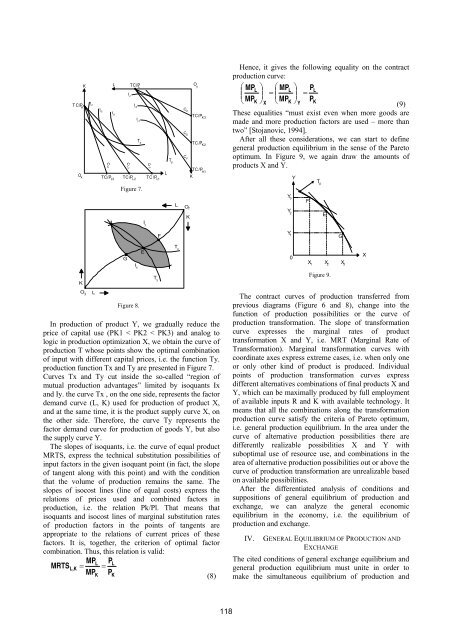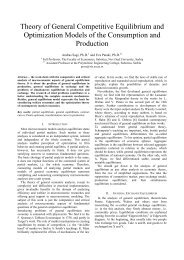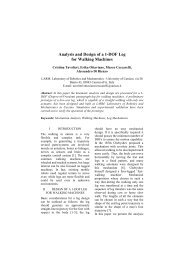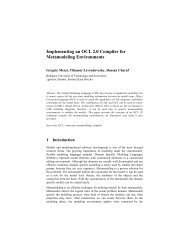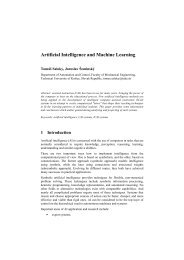Final Program EXPRES 2012 - Conferences
Final Program EXPRES 2012 - Conferences
Final Program EXPRES 2012 - Conferences
- No tags were found...
Create successful ePaper yourself
Turn your PDF publications into a flip-book with our unique Google optimized e-Paper software.
KTC/P KO xL TC/P O LyI y1I x1 I y2I C x2 y3Ix3TC/P K3I y3C y2T xTC/P K2Cx3C x 2C x1C y1T yTC/PLK1TC/P KL3 TC/P L2 TC/P L1Figure 7.Hence, it gives the following equality on the contractproduction curve:⎛ MPL⎞ ⎛ MPL⎞ PL⎜MP⎟ =⎜ =K MP⎟⎝ ⎠X⎝ K ⎠ PY K(9)These equalities “must exist even when more goods aremade and more production factors are used – more thantwo” [Stojanovic, 1994].After all these considerations, we can start to definegeneral production equilibrium in the sense of the Paretooptimum. In Figure 9, we again draw the amounts ofproducts X and Y.YT pLO YKY 3Y 2FEI yFGY 10KO XLGI xFigure 8.In production of product Y, we gradually reduce theprice of capital use (PK1 < PK2 < PK3) and analog tologic in production optimization X, we obtain the curve ofproduction T whose points show the optimal combinationof input with different capital prices, i.e. the function Ty.production function Tx and Ty are presented in Figure 7.Curves Tx and Ty cut inside the so-called “region ofmutual production advantages” limited by isoquants Ixand Iy. the curve Tx , on the one side, represents the factordemand curve (L, K) used for production of product X,and at the same time, it is the product supply curve X, onthe other side. Therefore, the curve Ty represents thefactor demand curve for production of goods Y, but alsothe supply curve Y.The slopes of isoquants, i.e. the curve of equal productMRTS, express the technical substitution possibilities ofinput factors in the given isoquant point (in fact, the slopeof tangent along with this point) and with the conditionthat the volume of production remains the same. Theslopes of isocost lines (line of equal costs) express therelations of prices used and combined factors inproduction, i.e. the relation Pk/Pl. That means thatisoquants and isocost lines of marginal substitution ratesof production factors in the points of tangents areappropriate to the relations of current prices of thesefactors. It is, together, the criterion of optimal factorcombination. Thus, this relation is valid:MPLPLMRTS L,K = =MPKPK(8)ET yT xX 1X 2X 3XFigure 9.The contract curves of production transferred fromprevious diagrams (Figure 6 and 8), change into thefunction of production possibilities or the curve ofproduction transformation. The slope of transformationcurve expresses the marginal rates of producttransformation X and Y, i.e. MRT (Marginal Rate ofTransformation). Marginal transformation curves withcoordinate axes express extreme cases, i.e. when only oneor only other kind of product is produced. Individualpoints of production transformation curves expressdifferent alternatives combinations of final products X andY, which can be maximally produced by full employmentof available inputs R and K with available technology. Itmeans that all the combinations along the transformationproduction curve satisfy the criteria of Pareto optimum,i.e. general production equilibrium. In the area under thecurve of alternative production possibilities there aredifferently realizable possibilities X and Y withsuboptimal use of resource use, and combinations in thearea of alternative production possibilities out or above thecurve of production transformation are unrealizable basedon available possibilities.After the differentiated analysis of conditions andsuppositions of general equilibrium of production andexchange, we can analyze the general economicequilibrium in the economy, i.e. the equilibrium ofproduction and exchange.IV.GENERAL EQUILIBRIUM OF PRODUCTION ANDEXCHANGEThe cited conditions of general exchange equilibrium andgeneral production equilibrium must unite in order tomake the simultaneous equilibrium of production and118


